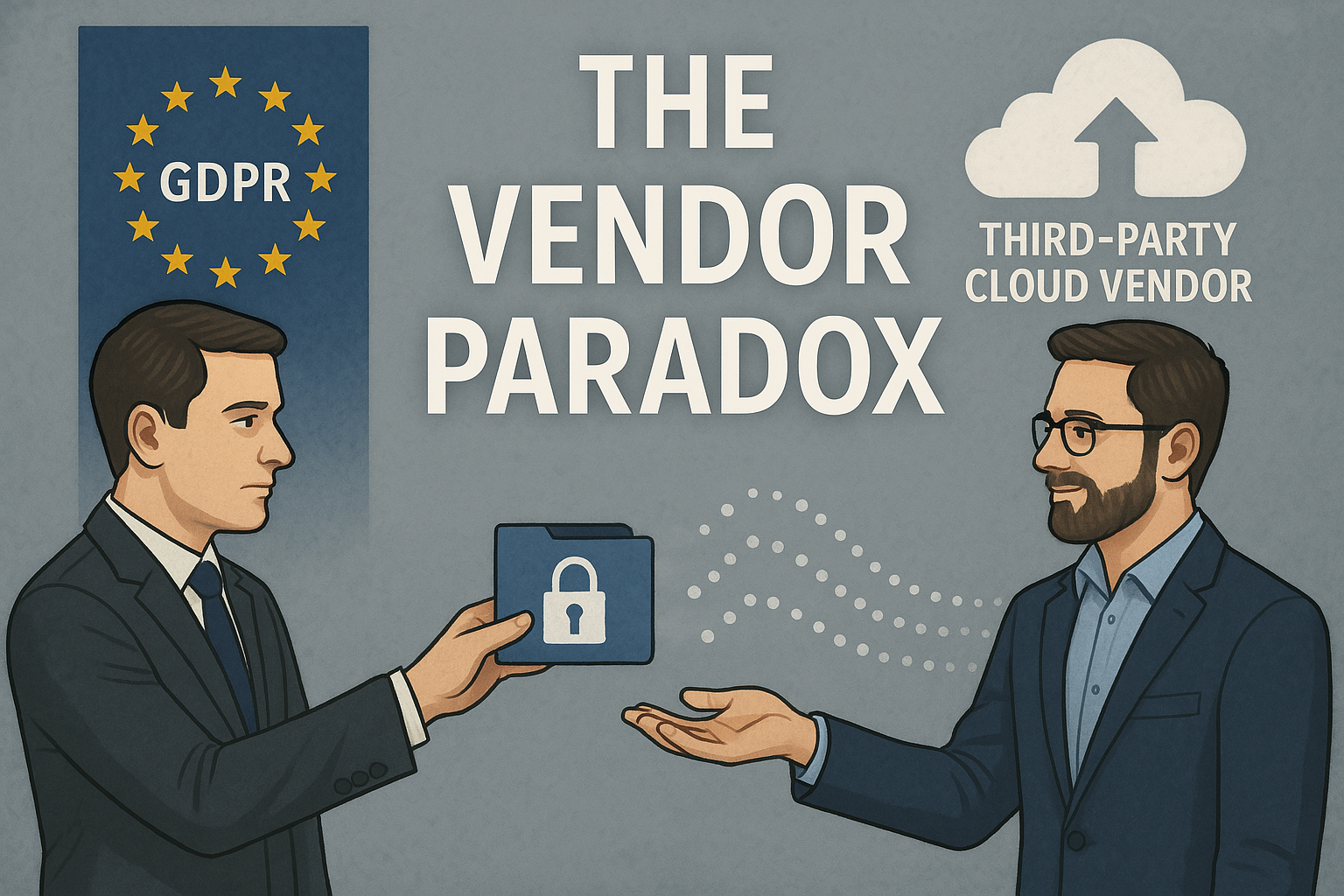The Vendor Paradox
When organizations rely on vendors to process personal data, they enter a complicated territory under the GDPR. While the law places full accountability on data controllers, it simultaneously recognizes the realities of third-party data handling. This creates a key challenge known as the Vendor Paradox.
In the broader landscape of GDPR paradoxes—including the Backup and Detection Paradoxes—the Vendor Paradox stands out. It illustrates the persistent disconnect between legal responsibility and operational visibility in vendor relationships. This article unpacks the paradox and explores how organizations can remain compliant despite limited control.
What Is the Vendor Paradox?
The Vendor Paradox arises from a fundamental contradiction in GDPR enforcement. Data controllers are legally accountable for the actions of their processors (vendors), but they often lack the tools or access to enforce GDPR requirements effectively across third-party environments.
Personal data shared with vendors can become shadow data—hidden in temporary files, obsolete systems, or cloud backups outside the controller’s purview. Even when data processing agreements (DPAs) are in place, residual data may persist in unexpected places.
Compounding the issue is the lack of real-time visibility. Controllers rarely have insight into how vendors manage data day to day. This makes it difficult to detect noncompliance, enforce deletion, or even confirm that data is stored securely.
Why the Vendor Paradox Matters for GDPR Compliance
Under Article 28 of the GDPR, data controllers must ensure that processors act only under their instructions and in full compliance with the law. Article 5(2) adds the accountability principle, requiring organizations to demonstrate this oversight in practice.
The stakes are high. If a vendor mishandles data—whether through negligence, outdated systems, or weak controls—the controller can still be held responsible. This liability persists even when the controller followed basic due diligence during vendor selection.
Unfortunately, due diligence alone isn't enough. Contracts may outline obligations, but operational opacity in vendor systems can leave compliance gaps. If data exists in backups or caches that the controller cannot access, the organization may inadvertently retain personal data beyond its lawful purpose—violating GDPR principles.
Legal and Operational Tensions
At the heart of the Vendor Paradox is a misalignment between legal expectations and technical realities. While controllers must enforce data deletion, vendors often lack robust deletion protocols or the infrastructure to fully comply.
Personal data might be:
- Cached in content delivery networks (CDNs)
- Stored in legacy systems without deletion capabilities
- Backed up in distributed cloud environments outside the EU
These technical limitations are rarely visible from the outside. Moreover, global vendors may host data across multiple jurisdictions, introducing additional complexity when GDPR's strict requirements clash with local data retention norms or infrastructure limitations.
The paradox grows as organizations scale. More vendors mean more risk, more data silos, and more uncertainty. Without tight control, even a well-intentioned vendor can become a source of non-compliance.
Practical Strategies for Navigating the Paradox
While perfect control isn’t possible, controllers can adopt proactive strategies to mitigate vendor-related risks and demonstrate GDPR compliance.
Strengthen Data Processing Agreements (DPAs)
DPAs should go beyond legal formalities. Include detailed clauses on:
- Data retention periods
- Secure deletion requirements
- Residual data handling
- Regular audit rights
Well-crafted contracts give controllers leverage in enforcement and provide clarity for vendors.
Conduct Regular Vendor Audits
Audit programs allow controllers to validate whether vendors are meeting contractual and GDPR requirements. These can include on-site visits, technical assessments, or self-attestation processes.
Where direct audits aren’t feasible, request third-party certifications or SOC 2 reports that include privacy controls.
Use Standardized Risk Frameworks
Adopting industry-standard tools like the Shared Assessments SIG or ISO 27001 can help streamline vendor risk assessments. These frameworks ensure consistent evaluation of data handling practices across the vendor ecosystem.
Maintain a Vendor Inventory with Data Mapping
Keeping a real-time inventory of all vendors and the data they process enables better oversight. Map out data flows to identify shadow data risks and understand where personal data may linger post-processing.
Define Strong Offboarding Protocols
When terminating a vendor relationship, ensure proper data deletion through exit clauses. Request formal deletion confirmations or certificates to reduce the chance of residual data lingering post-contract.
What Regulators Expect
Data protection authorities expect more than reactive responses. Controllers must show that they have built a governance structure that anticipates and mitigates vendor risks.
This includes:
- Comprehensive and specific DPAs
- Documented vendor selection processes
- Regular compliance reviews and audits
- Clear records of corrective actions when issues are identified
Regulators have already penalized organizations for failing to supervise processors appropriately. Even when data breaches occur on the vendor side, controllers remain on the hook for inadequate oversight.
Designing Accountable Vendor Relationships
Looking forward, privacy professionals should treat vendor relationships as part of the core privacy architecture—not just a procurement task.
Integrate Privacy into Onboarding
Include privacy assessments in the vendor onboarding process. Evaluate not just price or capability, but also compliance posture and data governance maturity.
Use Certification as a Selection Tool
Vendors with certifications like ISO/IEC 27701 or Europrivacy demonstrate a baseline of privacy readiness. These can help reduce the burden of custom assessments and build trust in third-party operations.
Move Toward Zero-Trust Models
Zero-trust approaches emphasize continuous verification and granular access controls. When extended to vendors, they limit data exposure and allow for better logging and oversight of third-party interactions with personal data.
Bridging the Accountability Gap
The Vendor Paradox reveals a critical blind spot in GDPR compliance. While controllers are responsible for personal data, they often lack the tools to fully control how that data is handled by vendors.
Still, accountability doesn't stop at the organizational boundary. With strong contracts, continuous oversight, and strategic governance, organizations can reduce the risks associated with third-party processing and demonstrate a commitment to compliance.
In the end, overcoming the Vendor Paradox requires a shift from passive oversight to active engagement—a necessary evolution in today’s privacy landscape.



